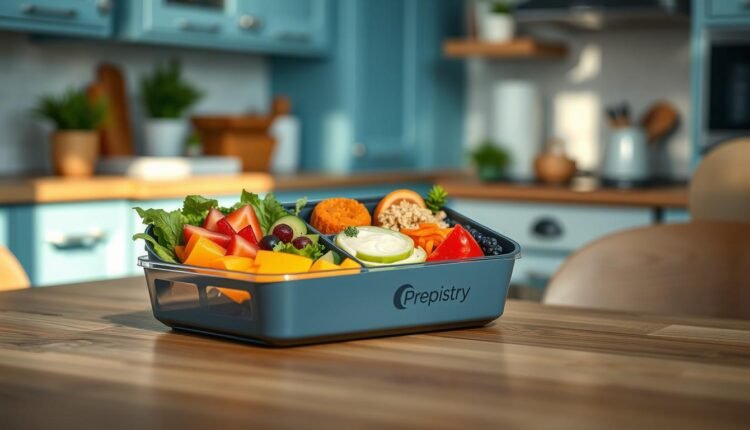Bento Lunch Meal Prep Ideas For Organized Portions
Discover practical bento lunch meal prep ideas for organized portions. Get simple, stress-free meal prep strategies for busy professionals and families.
Last Thursday, I found myself staring at a fridge full of mismatched containers while my kids asked (again) why their grapes tasted like garlic. That’s when I fully embraced the magic of compartmentalized meals—a system that’s been saving busy households in Japan for generations.
This approach isn’t about fancy recipes or picture-perfect arrangements. It’s about creating satisfying, balanced meals using what you already have—think roasted veggies from last night’s dinner paired with quick-boiled eggs and fresh berries. The real game-changer? Dedicated spaces for each component prevent flavor mingling and make portion control effortless.
Key Takeaways
- A system for creating organized, balanced meals in minutes using pre-prepped ingredients
- Strategies that prioritize both food presentation and practical daily use
Through trial and error—including that hummus-and-strawberry incident we don’t discuss—I’ve refined techniques that work for real-life schedules. Let me show you how to build flavorful combinations like zucchini noodle caprese or protein-packed tuna salads that stay fresh until lunchtime, using tools you likely already own.
The Art of Bento Lunches
The secret to stress-free midday meals might lie in a centuries-old Japanese tradition. Compartmentalized containers evolved from portable meals for travelers to an organized system that solves modern problems like flavor transfer and unbalanced eating.
These Japanese-style boxes balance aesthetics with practicality through deliberate arrangement. A typical setup includes 50% grains, 30% proteins, and 20% vegetables—a visual guide to portion control that works whether you’re packing teriyaki chicken or roasted veggie wraps.
Three key benefits make this approach revolutionary for busy lives:
- Components stay separated (bye-bye, pickle-flavored apples)
- Prep becomes faster using leftovers strategically
- Natural presentation upgrades make meals more satisfying
From sushi arrangements to how to assemble these boxes, the system adapts beautifully to Western tastes. I’ve used the same principles for Greek salad jars and protein-packed snack boxes that keep my clients energized till dinner.
What makes this method truly special? It turns routine fuel stops into moments of delight. Even my tuna wrap with cherry tomatoes gets elevated when arranged thoughtfully beside crisp cucumber coins.
Essential Tips for Successful Bento Box Lunches
When my daughter declared her carrots tasted like yesterday’s salmon, I knew we needed a better system. Compartmentalized containers became our solution for keeping flavors fresh and meals visually inviting.
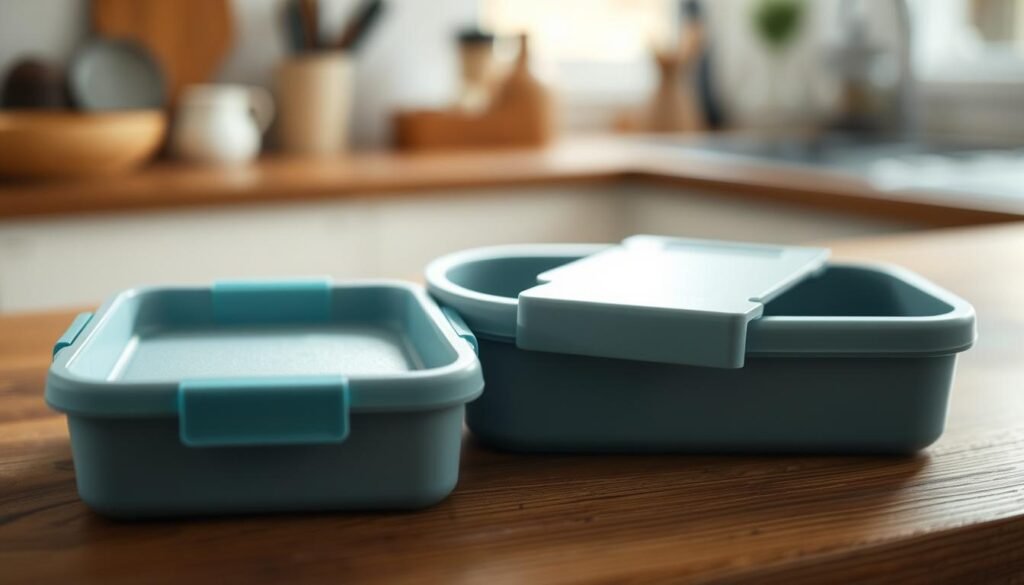
Balancing Nutrition with Variety
Think of your container as a canvas divided into food groups. Aim for 40% colorful veggies, 30% lean proteins, and 30% whole grains or fruits. This ratio ensures energy-sustaining combinations like grilled chicken with quinoa and roasted peppers.
| Category | Portion Size | Examples |
|---|---|---|
| Proteins | Palm-sized | Hard-boiled eggs, turkey slices |
| Vegetables | 2 fistfuls | Snap peas, cherry tomatoes |
| Grains | 1/2 cup cooked | Brown rice, whole-grain crackers |
Enhancing Presentation for Better Appeal
Color contrast matters more than artistic skill. Pair bright orange sweet potatoes with deep green spinach leaves. Use silicone dividers to create crisp lines between items—it takes seconds but makes meals feel special.
Keep portions snug but not crowded. Leave 1/4 inch space between items to maintain textures. Crunchy cucumber coins stay crisp when they’re not pressed against moist tuna salad. A well-arranged meal tastes better because we eat first with our eyes.
How Bento Boxes Simplify Meal Prep for Busy Days
Ever found yourself scrambling to pack food while your coffee cools? Compartmentalized systems turn chaotic mornings into grab-and-go victories. By dedicating Sunday minutes to pre-portioning ingredients, you create ready-made building blocks for the week.
Here’s why this works: divided spaces let you batch-cook proteins and chop veggies once, then mix combinations daily. A client recently shared,
“I went from 20-minute lunch packing to literally snapping lids on prepped sections.”
Three ways this approach saves time:
- Sunday assembly takes 15 minutes using roasted chicken, cooked grains, and washed greens
- Daily effort drops to 2 minutes – just grab and stack
- Leftovers transform into new creations (yesterday’s grilled veggies become today’s salad base)
For those craving variety, try adding heat with chili-lime dressings or toasted seeds. The real magic? You’ll actually use those pre-cut vegetables instead of finding them forgotten in fridge corners.
Parents and professionals alike report feeling less decision fatigue when options are visually organized. As one teacher told me, “Seeing everything separated makes me actually want to eat what I packed.”
Creative Bento Box Lunch Ideas for Professionals
Midweek office lunches often become a sad parade of soggy sandwiches and wilted salads. Let’s fix that with combinations that fuel productivity without demanding culinary expertise. My go-to solution? A vibrant zucchini noodle caprese layered with lemon-herb chicken—ready in 10 minutes using Sunday-prepped ingredients.
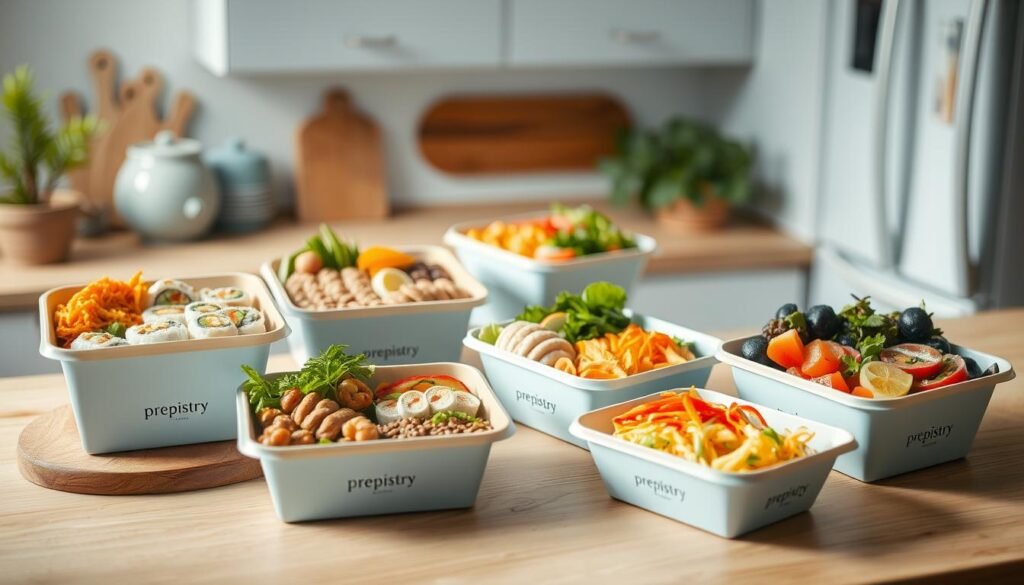
- Mediterranean tuna salad: Mix canned tuna with olives, cherry tomatoes, and a dollop of hummus
- Ginger-lime chicken skewers: Pair with jicama slaw and quinoa for crunch
- Deconstructed wraps: Keep whole-grain crackers separate from chicken salad and sliced veggies
A client recently told me,
“These compartmentalized meals finally made desk lunches feel like an actual break.”
The trick lies in strategic assembly—store dressings in tiny containers and place heartier items at the container’s base to prevent sogginess.
| Protein Base | Veggie Mix-Ins | Flavor Boosters |
|---|---|---|
| Shredded chicken | Spiralized zucchini | Pesto drizzle |
| Hard-boiled eggs | Roasted peppers | Everything bagel seasoning |
Need more inspiration? Explore these healthy lunch combinations that transform basic ingredients into energizing midday fuel. Batch-cook three proteins and two grains on Sunday, then create new combinations daily—your taste buds won’t know you’re eating planned leftovers.
Step-by-Step Guide to Assembling Your Bento Box
We’ve all opened a midday container to find soggy bread or wilted greens. The fix? A strategic assembly method that preserves textures and flavors. Let me walk you through my tested approach for creating organized, appetizing combinations.
Selecting Fresh, Healthful Ingredients
Start with crisp vegetables that hold up well—snap peas, radishes, and bell peppers stay crunchy for days. Pair them with proteins like grilled chicken strips or marinated tofu cubes. Seasonal picks add natural variety without extra effort. A client recently shared:
“Choosing rainbow-colored veggies first makes building balanced combinations effortless.”
Dividing and Presenting for Maximum Impact
Follow this sequence for foolproof assembly:
- Place moist items (dips, dressings) in small containers
- Arrange proteins in the largest compartment
- Fill remaining spaces with colorful vegetables
Use silicone baking cups as edible dividers between items like whole-grain crackers and sliced turkey. For sandwich components, keep bread separate from fillings until eating time to maintain texture.
| Component | Portion Tip | Texture Preserver |
|---|---|---|
| Leafy greens | Line container base | Paper towel layer |
| Crunchy veggies | Top with dressing cups | Separate compartment |
The magic happens when you treat each section as its own mini meal. Stack roasted sweet potato coins beside apple slices, or nestle almond butter next to celery sticks. This method turns ordinary food into an experience that delights both eyes and taste buds.
Innovative “bento lunch meal prep ideas” for Every Lifestyle
Last month, a client showed me her genius solution for picky eaters—mini frittatas baked in muffin tins with fresh spinach and sun-dried tomatoes. This sparked my exploration of adaptable combinations that suit different schedules without demanding kitchen marathons.
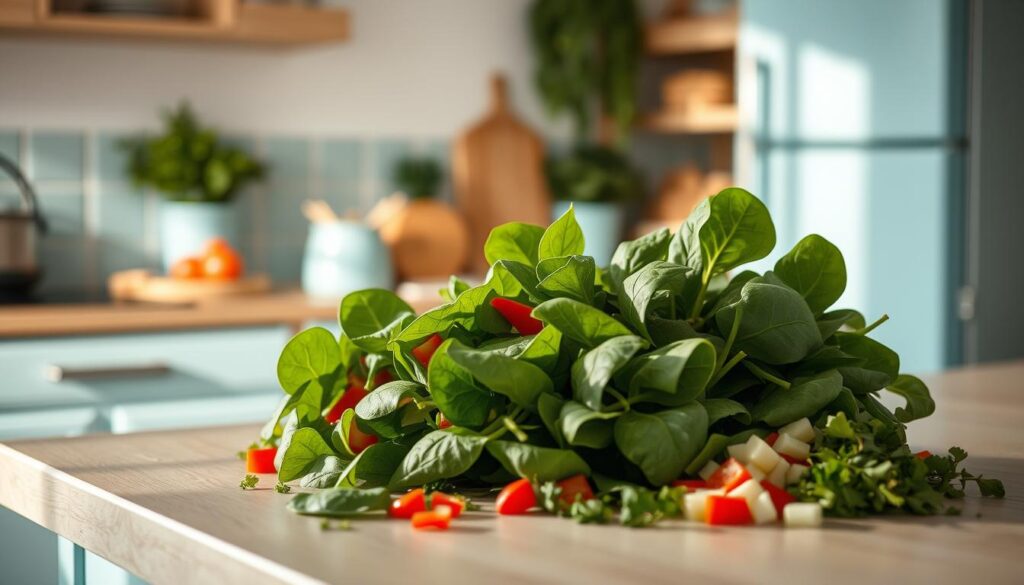
Busy professionals love our 10-minute protein boxes: pre-grilled chicken strips with massaged kale, quinoa, and lemon wedges. Parents rave about sweet potato toast “sandwiches” layered with almond butter and banana slices—a hit with kids and adults alike.
“These muffin tin frittatas changed our morning scramble into grab-and-go fuel,”
shared a nurse who meal preps during night shifts. Her secret? Whisking eggs with chopped spinach and roasted peppers every Sunday.
| Lifestyle | Recipe Hack | Time Saver |
|---|---|---|
| Students | Deconstructed sushi bowls | Use leftover rice |
| Fitness Focused | Turmeric chicken skewers | Marinate overnight |
Spinach becomes a flavor hero when blended into pesto for zucchini noodles or stirred into chickpea salads. Try roasting it crisp as a salty garnish—transforms any protein base in seconds.
The real magic happens when you view recipes as flexible templates. Swap chicken for marinated tofu, trade quinoa for farro, or mix up dressings using pantry staples. With smart prep, you’ll craft vibrant combinations that make midday breaks something to anticipate.
Healthy Bento Box Ingredients and Portion Control
Last month, a parent asked me why their third grader kept trading carrot sticks for cookies. The answer? Kids eat with their eyes first. Choosing vibrant, nutrient-dense components makes balanced eating effortless—for students and professionals alike.
Smart selection starts with building blocks that deliver maximum nutrition. Aim for:
- Crunchy vegetables (sugar snap peas, rainbow peppers)
- Lean proteins (turkey roll-ups, edamame)
- Whole grains (quinoa cups, whole-wheat pita)
“Since switching to compartmentalized containers, my kids actually finish their veggies first,”
shared a teacher who preps family meals weekly. The secret? Strategic placement and proper portions.
| Age Group | Protein Portion | Veggie Portion |
|---|---|---|
| 6-12 years | 1 oz (deck of cards) | 1/2 cup raw |
| Adults | 3-4 oz (palm-sized) | 1 cup cooked |
Keep components crisp with these hacks:
- Line compartments with paper towels for moisture control
- Pack dressings in reusable silicone tubes
- Use frozen berries as natural cooling packs
Active teens might need extra protein portions, while office workers benefit from smaller grain servings. Adjust based on energy needs—swap in hard-boiled eggs for athletes or add avocado slices for sustained focus during meetings.
The right way to maintain freshness? Layer ingredients strategically. Place heartier items like roasted chickpeas at the bottom, delicate greens on top. This approach works whether you’re packing for school or client presentations.
Family-Friendly Bento Box Meal Recipes

Balancing a toddler’s picky palate with a teen’s hunger can feel like cooking for two different restaurants. My solution? Build-a-bowl components that let everyone customize their plates from shared ingredients. This approach keeps mornings sane and after-school hangry meltdowns at bay.
Kid-Approved Flavors and Textures
Turn basic ingredients into edible adventures. Roll smoked salmon and cream cheese into pinwheel “sushi” slices, or shape Greek salad ingredients into muffin-tin frittatas. One parent client shared:
“My kids devour roasted sweet potato coins when I call them ‘orange power chips’.”
Three crowd-pleasing combos:
- Deconstructed chicken wraps with whole-grain tortilla slices
- Rainbow veggie sticks paired with yogurt-based dips
- Fruit kabobs alternating melon balls and berry “jewels”
Adjustable Meal Portions for All Ages
Use compartment dividers to scale portions without extra dishes. A 6-year-old might take two turkey roll-ups while Dad gets four. Try this flexible template:
| Age Group | Protein | Veggies |
|---|---|---|
| 3-6 years | 1 hard-boiled egg | 1/3 cup sliced cukes |
| 7-12 years | 2 oz grilled chicken | 1/2 cup bell pepper strips |
Prep smarter with Sunday slicing sessions. Store pre-cut veggies in airtight containers, and assemble sandwiches on busy mornings using pre-portioned fillings. Frozen grape clusters double as ice packs and sweet treats.
Budget-Friendly Bento Lunch Meal Prep Strategies
When a college student client showed me her $12 daily salad habit, we created a system that cut costs by 70% without skimping on flavor. The secret? Strategic ingredient overlap and smart batch cooking.
Versatile components like cheddar work triple duty—melted in sandwiches, cubed for snacks, or grated over roasted veggies. One block can fuel three days of meals when used thoughtfully. A parent recently shared:
“Prepping cheese sandwiches for Monday and using leftovers in Thursday’s egg muffins keeps our grocery bill predictable.”
Five money-saving tactics that maintain variety:
- Cook once, eat twice: Roast double the chicken for wraps and grain bowls
- Repurpose leftovers: Turn yesterday’s rice into tomorrow’s fried rice cups
- Buy in bulk: Divide large cheese blocks into portions for sandwiches and snacks
| Ingredient | Budget Use | Cost Per Serving |
|---|---|---|
| Chickpeas | Hummus, salads, roasted snacks | $0.35 |
| Seasonal carrots | Sticks, shredded toppings, soup base | $0.20 |
Try blending canned beans into spreads instead of buying pricey dips. Frozen veggies often cost less than fresh and retain nutrients better. Last week’s broccoli stems became today’s slaw—zero waste, full flavor.
Smart prep isn’t about deprivation. It’s about making ingredients work harder so you can enjoy bolder combinations without second-guessing every purchase.
Meal Prep Storage and Safety Tips
Last summer, a client’s turkey sandwich spoiled during a field trip—lesson learned. Keeping components fresh requires more than just sealed containers. The right storage strategy ensures crisp veggies and safe proteins, whether you’re packing for soccer practice or back-to-back meetings.
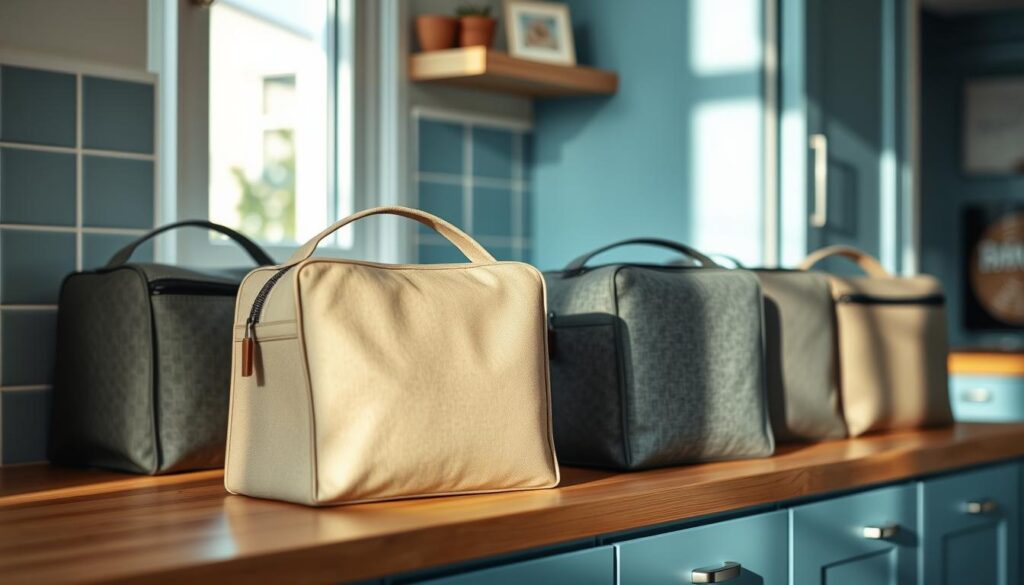
Utilizing Insulated Lunch Bags Effectively
Pre-chill your bag for 10 minutes before loading components. Place ice packs on top—cold air sinks, so this positioning cools contents evenly. For families, try frozen juice boxes that thaw into drinks by noon.
| Ice Pack Type | Best For | Chill Duration |
|---|---|---|
| Gel-based | Office settings | 4-5 hours |
| Stainless steel | Sports practices | 6+ hours |
| Frozen water bottle | School days | 3-4 hours |
Maintaining Food Safety on the Go
Proteins like chicken and pasta salads need to stay below 40°F. Nestle their containers between two ice sources, and pack dressings separately. A nurse mom shared:
“I freeze yogurt tubes as edible ice packs—my third grader gets a frosty treat and safe food.”
Adjust your approach seasonally:
- Summer: Use chilled thermoses for pasta dishes
- Winter: Insulate with foil-wrapped hot packs
For quick checks, tap containers—if they feel room temperature, prioritize eating those items first. This method works whether you’re managing a kindergartener’s snack box or your own conference-day fuel.
Quick Recipes: From Zucchini Noodle Caprese to Tuna Salad Sandwiches
After burning yet another batch of chicken while juggling Zoom calls, I realized weeknight dinners needed a rescue plan. These two flavor-packed combinations became my go-to solutions—they’re faster than waiting in a drive-thru line and far more satisfying.
Zucchini Noodle Caprese & Baked Chicken
Spiralize two medium zucchinis and toss with olive oil. Layer with halved cherry tomatoes, fresh basil, and mozzarella pearls. Pair with lemon-herb chicken breasts baked at 425°F for 18 minutes. This combo delivers 28g protein and three veggie servings per portion.
| Component | Prep Tip | Flavor Boost |
|---|---|---|
| Zucchini noodles | Salt and drain 10 mins | Balsamic glaze drizzle |
| Chicken breasts | Pound to even thickness | Garlic powder rub |
Tuna Salad Sandwich & Melon Salad
Mix canned tuna with Greek yogurt instead of mayo. Add diced celery and apple for crunch. Serve on whole-grain bread with a side of cubed cantaloupe and mint. A client raved:
“This sweet-salty combo makes me actually look forward to desk lunches.”
Both recipes use ingredients that keep well for three days. Store components separately, then assemble morning-of to maintain textures. Need extra zest? Add a smear of hummus to sandwich bread or toss melon with lime juice.
Bento Box Hacks for Work and School Lunches
Ever grab last night’s roasted veggies only to find them limp by midday? A few smart tweaks can transform basic components into crisp, satisfying combinations. Let’s explore practical upgrades that work whether you’re fueling a boardroom brainstorm or a science fair project.
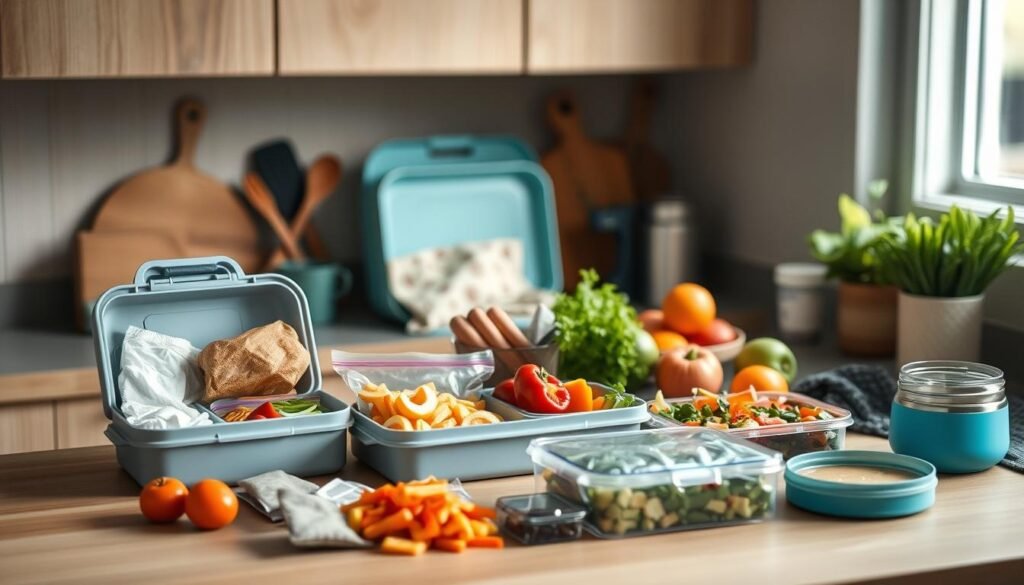
- Swap sandwich bread with zucchini slices for gluten-free “wraps”
- Turn pre-cooked eggs into portable snacks using silicone muffin cups
- Repurpose leftover grilled chicken as salad toppers or grain bowl mix-ins
“Glass containers with snap lids keep my toddler’s crackers crunchy and my salad greens intact,” shares a teacher who packs four boxes daily.
Adjust portion sizes effortlessly:
| Setting | Protein Hack | Veggie Solution |
|---|---|---|
| Office | 3 oz seasoned chicken strips | Pre-chopped bell peppers |
| School | 1 hard-boiled egg | Cherry tomatoes on vine |
Forget buying specialty gear—repurpose what you own. Ice cube trays separate dips from veggies, while mason jars create layered salads that stay fresh. Need inspiration? These creative school lunch combinations prove simple ingredients shine when thoughtfully arranged.
Shredded zucchini blends seamlessly into oatmeal muffins or egg bites, adding moisture without strong flavors. Pre-chop a week’s worth during Sunday prep—it takes 8 minutes but saves daily morning scrambles.
Incorporating Fresh Vegetables and Proteins Into Bento Boxes
Seasonal vegetables aren’t just fresher—they’re nature’s built-in flavor boosters. Pair crisp snap peas with roasted chicken in spring, or swap in roasted squash and turkey during fall. This rotation keeps meals exciting while maximizing nutrient density.
Smart Pairing Strategies
Choose vegetables that hold texture for hours. Sugar snap peas and radishes stay crunchy, while roasted sweet potatoes add hearty balance. Combine them with proteins like marinated tofu or shredded chicken for sustained energy.
| Season | Vegetable Pick | Protein Match |
|---|---|---|
| Spring | Asparagus | Lemon-herb salmon |
| Summer | Zucchini | Grilled chicken |
| Fall | Brussels sprouts | Apple-cider pork |
Balance soft and crunchy elements. Place rice or quinoa beside snap peas for contrast. A parent recently shared:
“Mixing warm grains with chilled veggies makes my kids actually finish their greens.”
Try these combinations:
- Jasmine rice + edamame + pickled carrots
- Farro + roasted chicken + sugar snap peas
- Brown rice cakes + smoked turkey + cucumber slices
For best results, prep proteins in bulk and rotate seasonal veggies weekly. This approach keeps costs low and flavors vibrant—no culinary expertise required.
The Role of Presentation in a Satisfying Bento Lunch
We’ve all packed a perfectly tasty lunch only to dread opening it later—because let’s face it, gray tuna salad isn’t inspiring anyone. Visual arrangement transforms fuel into an experience, activating our senses before the first bite. A study of office workers found 73% ate more veggies when presented in colorful, organized boxes versus mixed containers.
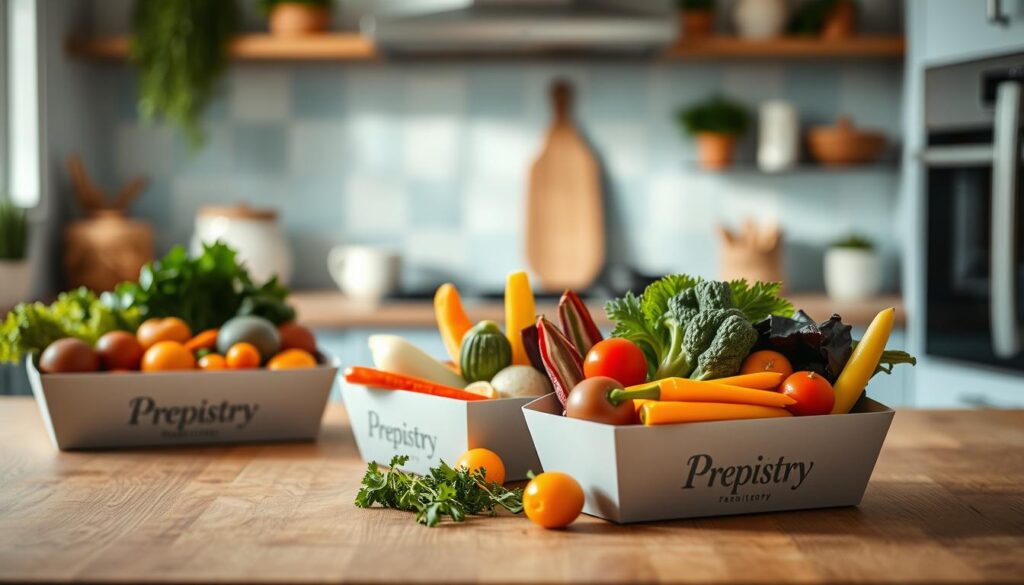
Think of your container as a canvas. Arrange bright orange carrots against deep purple cabbage leaves. Place crisp snap peas beside creamy hummus. These contrasts aren’t just pretty—they signal freshness and variety. One parent shared:
“My kids devour bell pepper strips when they’re fanned out like sun rays, but ignore them when dumped in a pile.”
Three presentation principles that work:
- Use natural dividers (cherry tomatoes separate rice from chicken)
- Layer textures vertically—crunchy veggies on top, softer grains below
- Add edible “confetti” like sesame seeds or microgreens
| Element | Strategy | Tools |
|---|---|---|
| Color | Pair 3+ contrasting hues | Rainbow peppers, beet slices |
| Texture | Mix crunchy/soft items | Radishes, avocado wedges |
| Shape | Cut veggies into varied forms | Star-shaped cucumbers |
Simple tweaks make boxes feel special. Roll turkey slices into pinwheels instead of folding. Stack roasted sweet potato coins like poker chips. These details require seconds but elevate ordinary ingredients into a lunch worth anticipating.
Tips for Varying Your Bento Lunch Compositions
A client once confessed she’d packed the same turkey sandwich for 14 days straight—until her kindergartener staged a lunchbox rebellion. This taught me the power of intentional rotation. Keep combinations fresh by treating your container like a modular palette where components swap effortlessly.
Start with a base formula: 1 protein + 2 veggies + 1 grain + 1 crunch factor. Change one element daily to prevent boredom. Monday’s grilled chicken becomes Tuesday’s curried chickpeas, while Wednesday’s pita transforms into Thursday’s sourdough crackers.
Three ways to reinvent your rotation:
- Swap bread types daily—try ciabatta, flatbreads, or make-ahead breakfasts waffles as savory bases
- Roast seasonal veggies in bulk, then mix colors and textures each morning
- Use dips as flavor anchors—hummus Monday, tzatziki Tuesday, guacamole Wednesday
| Bread Rotation | Veggie Pairings | Crunch Boosters |
|---|---|---|
| Whole grain wraps | Shaved Brussels sprouts | Toasted pepitas |
| Rye crackers | Blistered shishitos | Wasabi peas |
“Changing just the dip makes my kids think they’re getting全新 meals,” shared a mom who preps five days of veggies every Sunday.
Embrace flexible repetition—cook three proteins and four veggies weekly, then combine them differently. Roasted sweet potatoes can be Tuesday’s salad topper and Friday’s soup dipper. This strategy keeps taste buds guessing while streamlining prep time.
Transforming chaotic kitchen moments into organized nourishment doesn’t require perfection—just smart systems. Through trial and error (and yes, a few garlic-tainted grapes), I’ve seen how intentional planning turns ordinary ingredients into energizing daily fuel.
Portioned containers help us balance nutrition effortlessly—like pairing roasted carrots with protein-rich dips or layering crunchy veggies over grains. This approach cuts morning scrambles while keeping flavors vibrant. One parent recently shared:
“My kids now fight over who gets the orange coins—roasted carrots transformed their snack game!”
Whether you’re crafting desk-friendly combinations or kid-approved crunch fests, remember:
• Pre-prepped components turn hectic days into grab-and-go wins
• Strategic pairings (think crisp carrots + creamy hummus) boost satisfaction
• Simple swaps keep meals fresh without extra effort
Your turn—try spiralizing carrots into “noodles” or roasting them with cumin for savory salads. Share your clever twists in the comments below. Together, let’s make organized eating as joyful as it is practical.
Sesame Tofu & Snap Pea Bento with Coconut Rice
A vibrant and wholesome bento box featuring crispy sesame tofu, fresh snap peas, and fragrant coconut rice. Perfect for meal prep or a delightful lunch on the go.
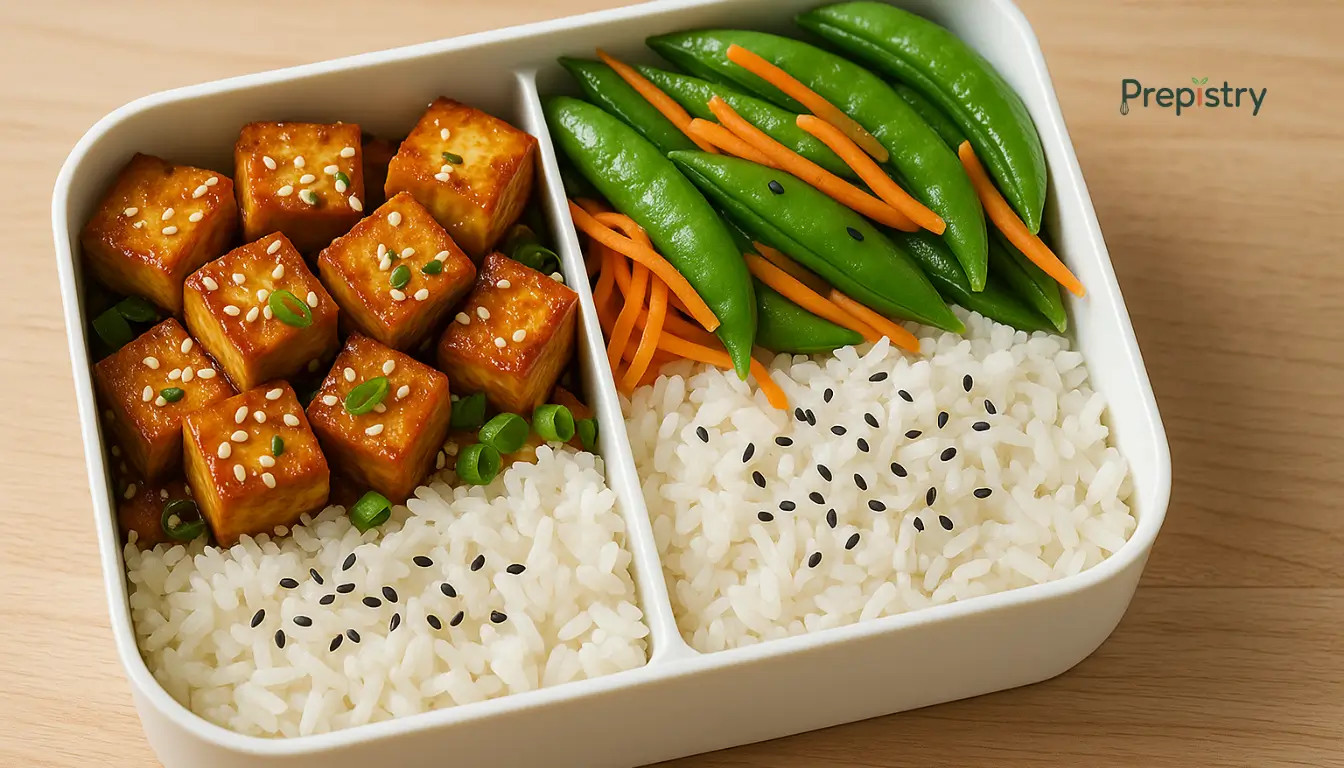
Nutrition Information
Equipment Needed
- Rice cooker
- Non-stick skillet
- Mixing bowls
- Bento boxes
- Knife
- Cutting board
Ingredients
-
1 cup jasmine rice
-
1 cup coconut milk
-
1/2 cup water
-
1/4 tsp salt
-
200g firm tofu, pressed and cubed
-
1 tbsp soy sauce
-
1 tbsp sesame oil
-
1 tbsp cornstarch
-
1 cup snap peas, trimmed
-
1 tbsp sesame seeds
-
2 green onions, sliced
-
1 tbsp vegetable oil
Instructions
Recipe Video
Sesame Tofu & Snap Pea Bento with Coconut Rice
Learn how to prepare a delicious and healthy Sesame Tofu & Snap Pea Bento with Coconut Rice. This step-by-step tutorial guides you through creating a perfect vegetarian bento box that's both flavorful and satisfying.

